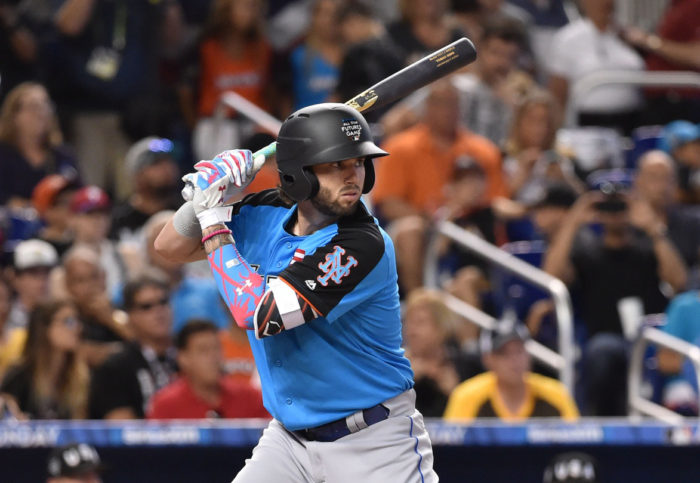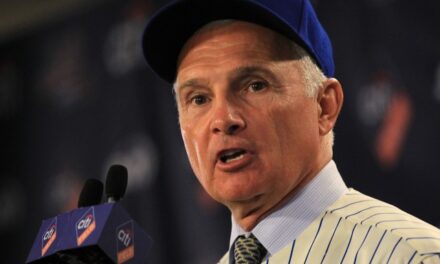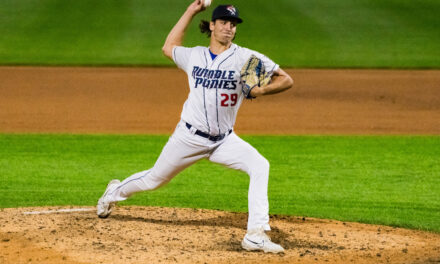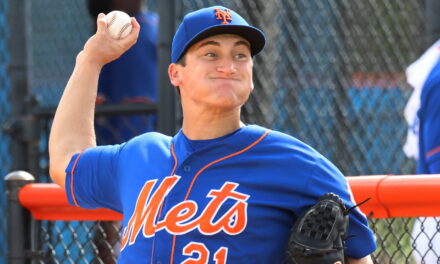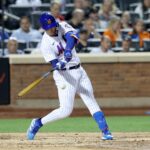
Over the last calendar year, Mets catching prospect Tomas Nido has burst onto the scene, establishing himself as one of the top prospects in the Mets organization.
A defense-minded catcher in the lower tiers of the minor league, Nido’s bat came alive last season with Single-A St. Lucie, hitting to a .320/.357/.459 clip, a .377 wOBA, .334 BABIP, 138 wRC+, seven long balls and 46 RBI across 90 games.
While Nido is still adjusting to the pitching at the Double-A level, his refined mechanics that he put into motion before his big 2016 campaign will look to carry him through the second half of this season.
The 23-year-old recently appeared in the MLB Futures Game and Double-A’s Eastern League All-Star Game just last week.
I had the pleasure of catching up with Tomas right in the thick of things to talk about his season and the feats he has accomplished this year.
Rob Piersall: Hey, Tomas! You were originally drafted in 2012 as a more light hitting, defensive-minded backstop, but last season with Single-A St. Lucie you really broke out at the dish. What changed for you? What did you do to see better results offensively?
Tomas Nido: I think I just tried to not swing too hard, battled through long at-bats and ended up winning [those] longer at-bats while also taking the ball the other way. I had better at-bats and wasn’t overly-aggressive and swinging at the first pitch too many times.
Piersall: How have you made that adjustment to facing a higher level of competition at Double-A this season? Have you tried to translate what you did last year into your game this season as well?
Nido: Yeah, I mean at the beginning of the year, it was a little different for me because I never played in the cold weather. So, I kind of went out of my approach just because I was trying either not to get jammed or just trying to do too much, knowing that I didn’t feel great at the beginning because I never performed in those kind of conditions, that kind of weather.
But as the season went by and got a little warmer, I started going back to my hitting plan and adjust the past couple weeks, I’ve been going up and down, every now and then I go out of my hitting plan, but the past few days it’s clicked and I feel much better so I’m excited for the second half.
Piersall: Winning the Florida State League batting title last year, while throwing out 42 percent of potential base stealers was a huge feat that helped earn you a 40-man roster spot. How did you achieve that success? What is your goal behind the plate?
Nido: The catching side is what I take pride in the most. Bob Natal, our catching coordinator, has really done amazing work with me from day one, to fix every little thing I needed to be extremely consistent when going out there. That is what made me a lot faster behind the plate and doing little things to make the mistakes a lot less frequent and to help the pitcher out.
That really helped me in a big way behind the plate. I’ve gotta give credit to our catching coordinator 100 percent on that side.
Piersall: We were talking about how you had to deal with the cold weather at Double-A and facing a tougher level of pitching. You got off to a bit of a slow start offensively, but have started to pick it up again recently. What has to be done the rest of the season so you can continue advancing towards your goal to get to the major leagues?
Nido: I have to be more selective at the plate. I think when I got up to .280 or something like that, I was feeling like myself and I had a really good feel at the plate, but I started getting a little too aggressive and obviously you have to be able to make adjustments a lot faster than in the Florida State League.
I think I just have to stay more selective at the plate and look for a pitch, not try to cover the whole plate and just be more patient, which is what I’ve been doing last couple games and it’s paid off.
You know, just not try to do so much and let the ball get to me, while not trying to be a hero every time. Let the momentum of the game dictate how I should go about it.
Taking it at-bat by at-bat, it will help me grow as a hitter and get back on track. I know I can catch and I know I can hit, I just have to be consistent and just be a little more patient.

Piersall: Congratulations on making the MLB Futures Game. When and how did you find out you would be representing the World team in Miami?
Nido: First of all, thank you.
We were in Hartford, and I first found out that morning about the Double-A All-Star game, then I also found out that Victor Caratini (Chicago Cubs catching prospect) had been called up that morning or the day before, so I knew he wasn’t going to make it to the Futures Game after all.
I knew the rosters hadn’t been announced, but with the season he was having, I was assuming he was a candidate as well as Francisco Mejia (Cleveland Indians catching prospect).
That was just a wild guess, and I can’t remember who told me, but they were like, “Hey, you never know! [Caratini] got called up, so you may have a shot,” but it never really crossed my mind.
But going up to the locker, our manager Luis Rojas, asked me what my email was. I said, “What for?” and he said, “You’re going to the Futures Game.”
I thought he was kidding at first, but he was serious and it was pretty cool the way he said it.
Piersall: What was your experience like playing with and against some of the best young talent in the game. I was following on TV and saw you get your two base hits. How was it playing at Marlins Park and being in that kind of atmosphere?
Nido: It was awesome! I’ve played with a lot of those guys before, but never at this stage, so it was a lot of fun being around that kind of talent.
Obviously, it was my first time at Marlins Park, so it was a lot of fun. It was an amazing experience playing with that kind of talent which makes it a lot more fun because the competition level is way higher.
Piersall: You came into the game a little bit later off the bench. When did you find out you would be going in?
Nido: They told us they were going to try and get us two at-bats, and Mejia was supposed to hit sixth in the fifth inning, so they said if he hits in the fifth you’re in, if not, he will catch the fifth, hit in the sixth inning and you will go in the bottom of the sixth to catch.
That’s what ended up happening, and I came on in the sixth inning. We had a long inning the following frame, so I got to hit in the seventh and I got to hit in the ninth. We had a couple of long innings and were able to put up a couple runs.
Piersall: A lot of people in the organization and fans alike have started to view you as the catcher of the future in Queens. Does that put more pressure on you or does it not really phase you?
Nido: No, it doesn’t really put pressure on me. It’s exciting to know that people see it that way and they recognize what I’m doing.
So, it’s really no pressure at all. It just makes me want to work harder to get there. I know a lot of people will be counting on me, so when I get my chance, I want to be ready.
Piersall: What do you want to accomplish going into the second half of your season, whether it be things to work on or things to continue to improve upon?
Nido: I definitely want to keep my catching at the level it’s been right now.
The most important thing I want to work on is my hitting, just stay consistent and take everyday one at-bat at a time. I think that is going to be a key part to the second half.
That will dictate what happens in the future. Take it at-bat by at-bat and hopefully everything will go as planned.
Piersall: Who were some of your favorite players growing up watching? Do you mold yourself after anyone whether it be offensively or behind the dish?
Nido: I’ve always really looked up to Ivan Rodriguez when I was a little kid, and I model my catching after Yadier Molina.
I love the way he plays, and that’s the way I try to be behind the plate.
The kind of player he is, he’s a leader. Both Pudge and Molina’s presence is felt when they are on the field.
Those are the players I looked up to and model myself after.
Piersall: So you liked Yadier Molina and Ivan Rodriguez, but did you grow up rooting for a specific team?
Nido: Honestly, not really. It was always just more of a player kind of thing. I used to like to watch Pudge and Jorge Posada as well.
I have family that live in Boston, so they are really big Boston Red Sox fans, but I’ve never been a fan of a specific team. Nothing like that, but more of a single player I’d look up to.

Piersall: Were you a catcher your entire time playing baseball, even as a little kid or did you transition? When did you start catching?
Nido: I always caught, but I played a little bit of third base, I played first base and probably a couple games in the outfield, but mostly first, third and catching. Those have always been the positions I played.
I’ve done a little bit of pitching, but not my strength. (Tomas laughs)
Piersall: Hey, well you know, when you get called up you may be called upon to pitch late in a game if the Mets are losing bad.
Nido: Ha, I’ll be ready.
Piersall: Apart from Amed Rosario who you played alongside in the Futures Game and yourself, what players in the Mets organization have you played with that are exciting that we should keep tabs on?
Nido: David Thompson. I love that kid. The way he plays his defense is unreal.
Everyone praises Luis Guillorme for his defense and you’ve gotta give credit where credit is due. Guillorme is a fine second baseman and you can put him wherever, but David Thompson is just as good.
They pull off some of the craziest plays I’ve seen, so I’ve gotta say David Thompson.
Patrick Biondi in the outfield is unreal, he’s got range like no other. Obviously Dominic Smith, everyone knows him. Matt Oberste has been hot the last couple weeks, those are my guys right there, as well as Kevin Kaczmarski.
Piersall: Give me a rundown of what a typical day in the minors is like. What time do you get to the ballpark? How do you go about your day leading up to game time?
Nido: It depends what time a game is at. If it’s a 7 p.m. game, we usually start to stretch around 2:30. I usually get to the field around 12:30, get something to eat, then see who we are playing and go over the lineups.
Then I go to the cage and start getting ready, get my swings in, then we do pitcher’s stretch and after we get done with the pitchers, I go hit in the cage.
Pretty much, then I’ll rest up when position players go out and get their work in, that’s when I get my break.
Then I’ll hit batting practice on the field. I’ll hit in the first group, and if I’m catching, I’ll hit in the fifth group then we come in and go over the lineups with the pitching coach and the pitcher that day.
After that, you just shower and get ready for the game, get some cards in until 30-45 minutes before the game when I’ll go out to the field.
Piersall: You really know the guys well that you pitch to, and that’s a big reason why you’re such a defensively sound catcher. It’s a bit derivative of what we’ve talked about, but what are your biggest strengths and weaknesses you want to work on?
Nido: My strength is definitely my arm, my defense, I can frame well. I like to think I make the pitchers look well, and help the pitcher get a couple of extra strike calls.
And my weakness, like I said, is definitely being less selective and going up their hacking without a plan, but I’m working on it everyday.
Piersall: Tomas, thank you so much for taking some time out to talk to me today, it was a pleasure.
Nido: Alrighty, no problem. Thank you!
Tomas can be found on Twitter at: tnido24.
Give him a follow and keep tabs on the rising catcher as he works his way up to the majors!


